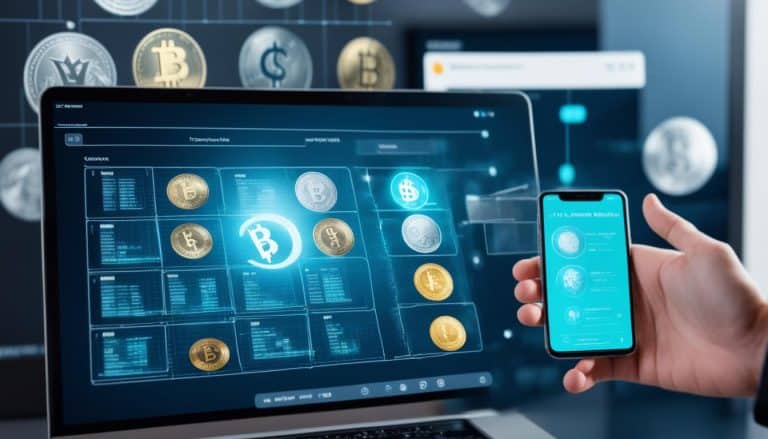Xrp For Financial Institutions
XRP is a digital asset built on the distributed and open source XRP Ledger. It is an enterprise grade blockchain protocol that has been adopted by numerous financial institutions as a payment settlement system. The XRP Ledger allows for near-instant payments with low transaction fees, which makes it an attractive option for banks and other financial institutions. This article will explore the advantages of using XRP for financial institutions, potential challenges that could hinder adoption, its potential impact on the wider financial system, use cases, banks and other organizations already using it, and how it works.
Overview of XRP
Ripple’s XRP is a revolutionary digital asset enabling real-time global payments for financial institutions. XRP is the native asset built on the Ripple protocol, with transaction speeds of just four seconds – making it one of the fastest transactions on record. It can also scale up to handle 1,500 transactions per second (TPS). This makes it an appealing option for businesses that require fast and reliable payment processing. Furthermore, its decentralized network does not suffer from scalability issues seen in other blockchain networks, allowing it to remain secure while operating at high speed and efficiency. As a result, XRP has become increasingly popular amongst financial institutions as they look to leverage its potential for faster and more cost-effective global payments. In conclusion, these advantages make XRP an attractive technology for financial institutions looking to build innovative payment solutions.
Advantages of XRP for Financial Institutions
Utilizing XRP as a digital asset offers financial institutions the opportunity to reap the benefits of faster and more cost-effective transactions, making it a real game changer in the industry. Cryptocurrency compliance is made easier with XRP’s built-in features that provide protection against fraud and money laundering. The technology also allows banks to take advantage of cost efficiency, making it easier for them to process payments at a fraction of the cost compared to traditional methods. Furthermore, XRP can settle payments within seconds, reducing settlement times significantly and providing better liquidity management for banks. All these benefits make XRP an attractive option for financially institutions looking to increase efficiency while managing risk. With these advantages in mind, it is easy to see why many financial institutions are considering adopting XRP on their platform. However, there are still challenges associated with its adoption which will be discussed in the next section.
Challenges of XRP Adoption
The adoption of XRP by financial institutions has been hampered by a number of challenges. The primary hurdle is regulatory uncertainty, as many jurisdictions have yet to provide clear guidance on how the technology should be treated and incorporated into existing legal frameworks. Additionally, there are concerns about liquidity in the XRP markets, as it is still relatively small compared to other cryptocurrencies such as Bitcoin or Ethereum. While these issues can be addressed with further research and education, it is likely that they will continue to impede progress until regulatory certainty and liquidity increase substantially.
Regulatory hurdles
Regulatory hurdles have presented an obstacle to the integration of XRP within financial institutions. Compliance burdens and scalability concerns are two primary issues that have been encountered when trying to develop a regulatory framework for XRP adoption. The first hurdle is that there are currently no specific regulations in place governing cryptocurrencies, so any new solution must be tailored to fit existing laws. This can create a compliance burden on financial institutions as they attempt to conform their operations to meet these requirements. Additionally, some of the existing regulations may not be suitable for cryptocurrency transactions due to their complexity or lack of scalability. This could prevent financial institutions from using XRP as an efficient way of transferring funds. To overcome these barriers, more research into the development of a regulatory framework specifically designed for cryptocurrencies needs to be conducted. By doing so, it would reduce the compliance burden and provide more flexibility in developing solutions tailored towards XRP adoption by financial institutions. Furthermore, this would also help increase liquidity in the market by providing greater access and visibility for potential investors and users alike. Ultimately, such efforts would help advance the adoption of XRP as a viable option within the financial sector.
Limited liquidity
One of the key challenges for adoption of cryptocurrencies is limited liquidity, with only 3.5% of total cryptocurrency market capitalization represented by XRP. Liquidity issues may arise due to high volatility and scalability issues associated with the XRP network. This impacts the ability of financial institutions to effectively utilize XRP as a medium for international payments, as it requires large amounts of capital to move in and out of markets quickly. Furthermore, there is a risk that transactions could be stuck or delayed due to insufficient liquidity within the network. As such, financial institutions must account for these risks before implementing any solutions that involve XRP into their operations.
Overall, while liquidity remains an issue in an ever-evolving cryptocurrency market, there are potential solutions available for addressing this challenge which may enable greater adoption among financial institutions looking to leverage XRP technology. Moving forward, careful consideration should be given to how best to use xrp within the global payments system in order provide increased scalability and efficiency without compromising on security or liquidity levels.
XRP’s Potential Impact on the Financial System
XRP has the potential to revolutionize the financial system by providing a faster, more secure, and cost-efficient means of transferring funds. It could allow for payment solutions that are much quicker than current systems, with transactions settled within seconds rather than days. Additionally, XRP’s blockchain technology can help increase scalability and reduce costs associated with transactions while still maintaining security. Furthermore, its distributed ledger technology could create an immutable record of all transactions on the network without requiring third-party verification or trust in a central authority. Finally, XRP could provide real-time liquidity for financial institutions by eliminating counterparty risk and allowing them to securely transfer funds anywhere in the world quickly and easily:
• Faster transaction speeds than existing payment systems
• Increased scalability due to distributed ledger technology
• Reduced costs associated with cross-border payments
• Security provided by cryptography on the blockchain network
• Real-time liquidity for financial institutions via XRP tokens
These potential advantages make it clear why XRP is seen as a viable option for modernizing global finance. By leveraging this revolutionary technology, financial institutions have an opportunity to remain competitive in a fast-paced digital economy.
XRP Use Cases
As a decentralized digital asset, XRP has the potential to provide innovative solutions for various use cases across industries. One of the most promising use cases is for real time payments and cross border payments. XRP transactions settle in a few seconds with very low transaction fees, making it an attractive option compared to traditional banking systems which take days or weeks to settle with much higher fees. This makes it ideal for international payments where speed and cost are important factors. Furthermore, its underlying technology enables financial institutions to make transfers easier and more secure than ever before, allowing them to reduce costs and increase efficiency without sacrificing accuracy or reliability. In addition, XRP’s distributed ledger technology also provides enhanced security features such as transparency and immutability which can be beneficial for both parties involved in a transaction. All these features make XRP an attractive option for banks and financial institutions looking for faster, cheaper, and more secure ways of transferring funds between countries.
Banks and Financial Institutions Using XRP
Banks and other payment providers are increasingly recognizing the potential for XRP to streamline cross-border payments, resulting in more efficient, cost-effective transfers. The XRP protocol provides a set of standards that enable banks to perform secure and reliable transactions on its network. Furthermore, the technology offers scalability issues compared to other traditional payment systems as it can process thousands of transactions per second with minimal latency. This makes it an attractive choice for financial institutions looking to optimize their international payments infrastructure.
The advantages offered by the XRP protocol have positioned it as one of the most suitable solutions available for global financial institutions when sending money across borders quickly and securely. With this technology, banks can move funds faster than ever before while also reducing costs associated with international payments. Thus, XRP has become an important asset for many financial institutions that need efficient solutions for their global banking needs. By transitioning into using the XRP ledger, these organizations are able to take advantage of its capabilities and gain a competitive edge in a rapidly evolving marketplace.
The XRP Ledger
XRP has been adopted by many banks and financial institutions as a payment solution due to its fast transaction speeds. The technology that enables this is the XRP Ledger, which is an open source decentralized digital ledger. It facilitates secure, instant payments with no risk of double spending and provides an immutable record of all transactions on its network. This level of security makes it attractive to banks and financial institutions for use in their operations.
The XRP Ledger also offers two distinct advantages over other digital ledgers: it can settle transactions almost instantly, meaning there is no need to wait for payment confirmations; and its network security ensures that all funds are safe from malicious actors or fraudsters. These features make the XRP Ledger well suited for high-value payments between banks and other financial institutions, enabling them to transfer money more quickly, securely, and efficiently than ever before.
Thanks to the XRP Ledger’s advanced features, banks and other financial institutions can now benefit from faster transfers while enjoying increased protection against fraud or theft. With these advantages in mind, it’s clear why so many businesses have chosen to incorporate XRP into their operations – paving the way for RippleNet applications which provide even greater efficiency in cross-border payments.
RippleNet
RippleNet is a global payments network which utilizes the Interledger Protocol (ILP) to achieve interoperability between different ledgers and payment systems. This allows for seamless transactions across borders, regardless of currency or payment type. XRP Connect further enhances this ability by providing access to ILP-enabled networks through a single connection using XRP as a bridge asset. As such, RippleNet has become an increasingly attractive option for financial institutions looking to reduce cost and complexity when conducting international payments.
Interoperability
Interoperability is an essential capability of RippleNet, enabling it to serve as a bridge between different payment interfaces and networks, allowing value to be transferred effortlessly and securely. For example, banks can use XRP to facilitate payments between two distinct systems that might otherwise not be able to communicate with each other – much like a conductor leading an orchestra in harmony. Through its decentralized exchange feature, RippleNet enables users to move value across different networks and currencies without the need for intermediaries or third-party services. Additionally, smart contracts allow for automated transactions based on predetermined conditions without the intervention of a middleman. Finally, Interledger Protocol (ILP) provides end-to-end settlement assurance between multiple parties in real time while maintaining privacy throughout the process. This interoperability helps ensure that all participants are able to access global liquidity quickly and efficiently.
Interledger Protocol
Interledger Protocol (ILP) offers a secure and reliable way of transferring value between two or more different payment networks, allowing for seamless global payments. This protocol is built on top of XRP, a distributed ledger technology that provides support for smart contracts and facilitates the transfer of digital assets across multiple networks. ILP also allows transactions to be routed through multiple nodes in order to ensure maximum security and reliability. The protocol works by using an intermediary called the Interledger Connector which acts as a bridge between two different payment systems, allowing them to communicate with each other without requiring any manual intervention from either party. As such, ILP can offer banks and financial institutions an efficient and cost-effective solution for international payments, enabling them to move funds quickly and securely across borders.
Given its ability to facilitate rapid cross-border payments, ILP can help financial institutions increase their operational efficiency while ensuring compliance with local regulations. Moreover, because it is built on top of XRP’s distributed network architecture, ILP provides access to additional features such as enhanced privacy controls and improved scalability. With these advantages combined with its low transaction fees, ILP has become an attractive option for many financial institutions looking for new ways to connect with customers worldwide. As such, xrp is becoming increasingly popular amongst financial institutions as they look towards leveraging this advanced technology for their own operations. Moving forward, connecting xrp with other payment networks through the Interledger Protocol could open up new possibilities for global payments in the future.
XRP Connect
XRP Connect is a distributed ledger technology that enables the seamless transfer of digital assets between different payment networks, providing an efficient and cost-effective solution for international payments. As the saying goes, ‘A chain is only as strong as its weakest link’, XRP Connect reinforces this notion by connecting disparate payment systems to form a reliable global network. This technology offers several advantages such as:
- Network effects – XRP Connect allows financial institutions to leverage network effects by integrating with other payment networks, thus leading to more liquidity and greater scalability issues.
- Scalability – The technology is highly scalable, allowing for faster transactions and better performance at peak times.
- Security – It offers enhanced security due to its decentralized nature, which makes it virtually immune from hackers and other malicious actors.
Overall, XRP Connect provides a reliable and secure platform for international payments while also addressing scalability issues associated with traditional payment systems. With its ability to connect disparate payment systems together into one global network, it has become an attractive choice for financial institutions looking to streamline their operations.
Frequently Asked Questions
How secure is XRP compared to other cryptocurrencies?
XRP is a cost-effective and decentralized cryptocurrency, making it highly secure compared to other cryptocurrencies. Its technology is advanced and secure, utilizing encryption techniques to ensure transactions occur safely and securely. It offers a level of reliability not found in other digital currencies.
What are the risks associated with using XRP for financial institutions?
XRP offers cost efficiency and transaction speed, however, there are associated risks to consider. These include operational risk such as network outages, legal risk due to evolving regulations and security risks posed by malicious actors. Therefore, it is important for organizations to weigh the benefits against potential risks when utilizing XRP technology.
Are there any regulatory concerns about XRP?
Imagery of a bustling stock market appears; adoption and usage of XRP in the private sector is increasing, raising questions of its regulatory status. Blockchain technology is quickly gaining momentum, yet potential pitfalls are also present. An analytical approach to understanding XRP must be taken to understand the regulatory concerns surrounding it.
How much does it cost to use XRP for financial transactions?
The implementation costs and transaction fees of using XRP for financial transactions vary depending on the type of transaction. Generally, there are no additional costs associated with the use of XRP beyond the standard fees incurred when exchanging currencies.
Are there any potential scalability issues with XRP?
Ripple’s network has been designed to process up to 1,500 transactions per second, however scalability issues may arise depending on the number of participants and transaction costs. High traffic could potentially increase latency and transaction fees.






 Bitcoin
Bitcoin  Ethereum
Ethereum  Tether
Tether  XRP
XRP  USDC
USDC  TRON
TRON  Lido Staked Ether
Lido Staked Ether  Dogecoin
Dogecoin  Figure Heloc
Figure Heloc  Cardano
Cardano  WhiteBIT Coin
WhiteBIT Coin  Bitcoin Cash
Bitcoin Cash  Wrapped stETH
Wrapped stETH  Wrapped Bitcoin
Wrapped Bitcoin  USDS
USDS  Wrapped eETH
Wrapped eETH  Binance Bridged USDT (BNB Smart Chain)
Binance Bridged USDT (BNB Smart Chain)  Chainlink
Chainlink  Monero
Monero  LEO Token
LEO Token  WETH
WETH  Zcash
Zcash  Stellar
Stellar  Coinbase Wrapped BTC
Coinbase Wrapped BTC  Ethena USDe
Ethena USDe  Hyperliquid
Hyperliquid  Litecoin
Litecoin  Sui
Sui  Avalanche
Avalanche  Hedera
Hedera  sUSDS
sUSDS  Shiba Inu
Shiba Inu  Dai
Dai  USDT0
USDT0  Canton
Canton  Toncoin
Toncoin  PayPal USD
PayPal USD  World Liberty Financial
World Liberty Financial  Uniswap
Uniswap  Cronos
Cronos  Ethena Staked USDe
Ethena Staked USDe  Mantle
Mantle  USD1
USD1  Polkadot
Polkadot  Rain
Rain  Bitget Token
Bitget Token  MemeCore
MemeCore  Tether Gold
Tether Gold